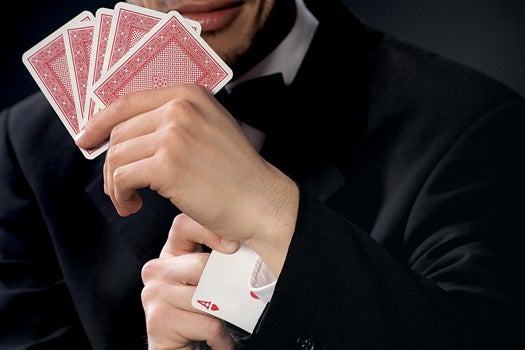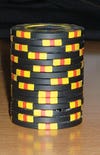In January, at the newly opened $4-billion Cosmopolitan casino in Las Vegas, a gang called the Cutters cheated at baccarat. Before play began, the dealer offered one member of the group a stack of eight decks of cards for a pre-game cut. The player probably rubbed the stack for good luck, at the same instant riffling some of the corners of the cards underneath with his index finger. A small camera, hidden under his forearm, recorded the order.
After a few hands, the cutter left the floor and entered a bathroom stall, where he most likely passed the camera to a confederate in an adjoining stall. The runner carried the camera to a gaming analyst in a nearby hotel room, where the analyst transferred the video to a computer, watching it in slow motion to determine the order of the cards. Not quite half an hour had passed since the cut. Baccarat play averages less than six cards a minute, so there were still at least 160 cards left to play through. Back at the table, other members of the gang were delaying the action, glancing at their cellphones and waiting for the analyst to send them the card order.
The gang had just walked away from Macau, the largest gambling city on Earth, with millions. They took $100,000 from the Bicycle casino in Los Angeles only weeks after the Las Vegas run. The Cutters’ scam did not require marking or switching cards, so casinos’ card scans and tracking software was irrelevant. Security consultants say that the gang numbers about 70. (With so many players, facial analytic software is easy to beat.)
Click here to launch a gallery of ways casinos catch cheats, and ways cheats beat the system.
At the Cosmopolitan, about 25 black-domed surveillance cameras hang from the ceiling above the high-stakes baccarat tables. Camera feeds, card scans, information about individual betting chips, and even biometrics about players are fed to a security suite at most new casinos, where software analyzes the data to determine betting outcomes in real time. a Cosmopolitan security official hovered a few feet behind the players, too, tracking wins, losses and betting patterns to identify cheats like the Cutters. Jeff Voyles, a hotel management instructor at the University of Nevada at Las Vegas, says that a new casino will spend at least $10 million on its surveillance.
Even so, casinos lose 6 to 8 percent of their revenue every year to some form of cheating, and sophisticated hustlers can take as much as $500,000 in just an hour. As cameras get better, smaller and cheaper, the cheaters are gaining an edge and casinos are struggling to keep up. “We’re really buried in tech and don’t know how to get out,” Voyles says, adding that because security systems don’t generate income, casinos are slow to update.
Cheaters Often Hide Cameras In Betting Chips Like These
But that night at the Cosmopolitan, the house won. One of the Cutters slipped up, and security was alerted. Nevada Gaming Board agents were called in and shut down the game and detained the players. Still, they couldn’t find a camera. Bill Zender, a security contractor for high-end casinos, says that the agents didn’t find anything because they couldn’t get a warrant to search the gamblers. Video footage showed no illegal moves or suspicious behavior, and under Nevada law, the agents didn’t have probable cause to perform a full body search. The cutters were released.
In May, some of the Cutters were finally caught. A casino surveillance manager in the Philippines spotted a “spatula like” camera hidden up a baccarat player’s sleeve and he identified four more likely gang members nearby. meanwhile, casinos are considering installing counter-surveillance scanners that detect the low-frequency sound that video cameras emit.
Not four miles from the Cosmopolitan, you can buy such a scanner for $720 from Fox’s Spy Outlet. Manager Andrew Rowles will tell you that it has a range of only a few feet, and it might be picking up a cellphone, not a video camera. Rowles can also sell you a camera to beat the scanner. It’s hidden in a stick of gum and costs just $150.
Face Time
Casinos use facial recognition software to match video recordings of patrons with a database of known cheaters. But backlighting, head movement, and hats and sunglasses are enough to stymie the matching process. in June, Biometrica, which has sold facial recognition software to up to 175 casinos, introduced a system that takes nine photos of a gambler’s face from different angles in areas where the lighting is consistent—on escalators, in turnstiles, or standing in front of ATMs—and compiles the shots for a clearer picture.
Tagged Chips
Assigning a unique radio-frequency identification (RFID) serial number to each betting chip eliminates counterfeiting, and stolen chips can be deactivated. The company Gaming Protection International uses RFID sensors and electronic tags loaded with information, such as the cash amount of the chip, so casino security can track how much money is on the table. Casino de Genting in Malaysia uses RFID-enabled baccarat tables to prevent cheaters from slipping more chips onto the table after a win.
The Trojan Horse
In 2009, a hacker was caught after he installed a program that took over the credit meter on a slot machine. after deliberately jamming the machine by sticking his finger in the payment slot, he called a casino tech to fix it. With the machine open, the hacker peered inside to locate the input-output slot on its computer. Once the tech left, the hacker deftly inserted a wire into the slot through a gap between the lower and upper doors of the machine. He then plugged in a chip with a program that gave him 50 credits every time he punched a button connected to the chip.
The Holdout Device
The old card-up-the-sleeve device dates back to the 19th century, but a skilled team of South Korean gamblers netted upwards of $1 million before authorities at Connecticut’s Foxwoods Resort Casino caught on to their improved technique in January of this year. Using a long stick with a hinge on the end, one gambler swapped cards in and out of a baccarat game while his partner used her body to shield his hand and distracted security employees with pleasant conversation.
Table Eye
Overhead cameras send images back to the surveillance suite, where character-recognition software reads the cards. The casino’s surveillance team can then follow each hand and spot switches and false shuffles. For blackjack, the software can instantly compare actual game outcomes with what would have happened if every player made the smartest decisions with the cards they were dealt. Cheats leave a trail of improbably lucky wins.
The False Shuffle
In 2002, a husband-and-wife team of card dealers in San Diego launched a card-cheating scam that would ultimately involve over 40 accomplices and net up to $7 million from 29 casinos during a 5 year run. The Trans would corrupt dealers into the scam in order to execute the sleight-of-hand called the “false shuffle.” Using a cellphone or a miniature transmitter on the lapel, spotters near the table during normal play would relay the order of a “slug,” or section of the deck, to a game analyst off-site.* The dealer would then perform the “false shuffle” — fooling the overhead surveillance camera by appearing to shuffle the deck, while leaving the “slug” intact. The game analyst used card tracking software to determine winning hands and then transmitted them back to the spotters, who would use hand signals for what the players should do — “almost like a catcher giving signs to the pitcher in baseball,” says FBI special agent Peter Casey.
Smart Shoe
In 2009, a Japanese card manufacturer introduced a device called angel eye that uses a scanner hidden in the shoe, the plastic card case dealers use, to track unique codes on each card. Dealers scan when they deal and rescan at the end of each hand. If a cheater swaps in a card that’s different than the one he was dealt, a computer linked to the shoe detects the discrepancy.
The Cut
In baccarat, the dealer presents a player with a card to cut the deck before play. Using the cut card, the cheater shields his index finger from view while he brushes the edge of the deck. A camera on his sleeve records the card order. The player leaves the table and passes the camera to an accomplice. The video is slowed down, the card order determined, and the results sent to confederates back at the table.
The Auto-Shuffler
The Macau Police Judiciary busted 7 Chinese nationals in March for cheating unnamed casinos on the island out of the equivalent of $3 million U.S. dollars, by secretly installing mini-cameras and reflective mirrors in automatic card-shufflers at baccarat tables. The camera rig wirelessly beamed video images of card order to a game analyst at an off-site hideout. Determining card order by analyzing the video took 1 to 2 hours, at which time the analyst then sent cheat instructions to accomplices via mobile phone. Casino employees discovered the cameras during routine maintenance in January, with the perpetrators finally arrested in March. Suen Kam-fai of the Macau Judiciary Police told the Hong Kong newspaper The Standard that syndicate members switched the doctored machines into games by using distraction techniques. The Police Judiciary is still investigating whether dealers were complicit in the scam.









